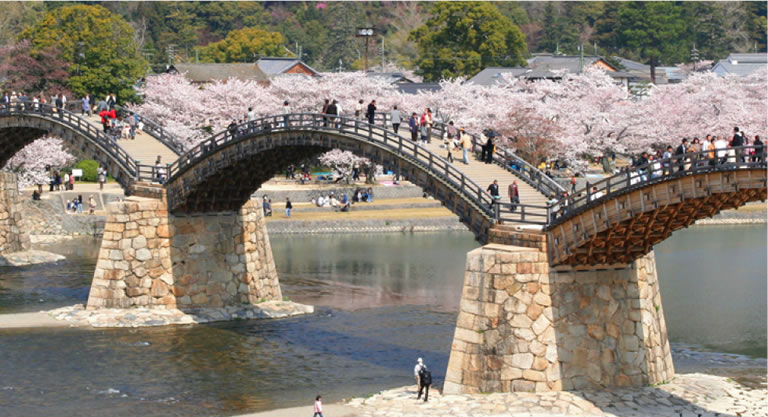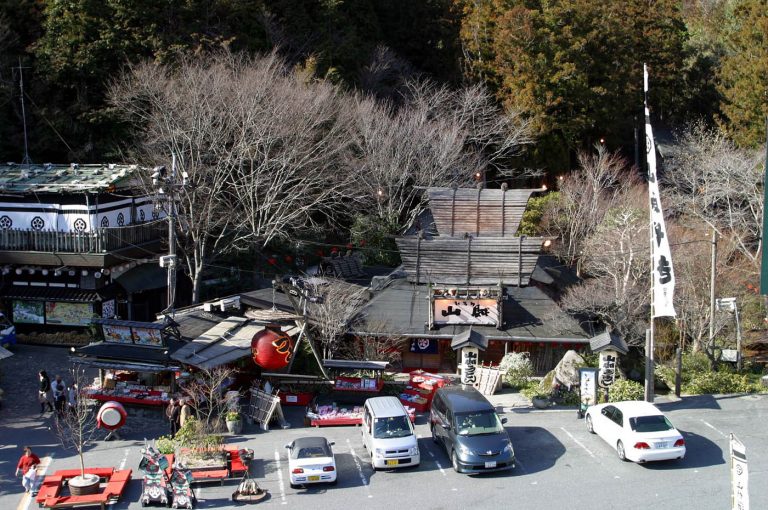100 Stories
Beyond Kintaikyo: Overlooked Attractions Just Outside Iwakuni
When tourists have a limited amount of time in the Hiroshima area, the two places that are sure to be on the itinerary are Miyajima and downtown Hiroshima (Peace Memorial Park, the Atomic Bomb Dome, Hondori, Hiroshima Castle, and maybe Shukkeien). They tend to try to squeeze all that into two days (too brief if you ask me), and if time permits afterward, they might swing by Okunoshima or Onomichi on the third day, but another popular choice tends to be Iwakuni, which is technically in Yamaguchi Prefecture, but more than doable as a day trip because it’s just across the border. Iwakuni is most famed for Kintaikyo, an elegant, arched bridge that bounces over the Nishiki River, Kikko Park, which lies on the northwest end of the bridge, and Iwakuni Castle, perched on top of a hill but a brief ropeway ride and easy climb from Kikko Park. While all that can easily fill an entire day, Iwakuni and its surrounding area–just like Hiroshima–is a full-fledged city that’s more than just its tourist attractions. Thus, to say that one has “done” Iwakuni just from the above locations is a bit of a waste, and with the right transportation connections, a full day could have visitors seeing more than just Kintaikyo, and even tempt them into spending a second day here.
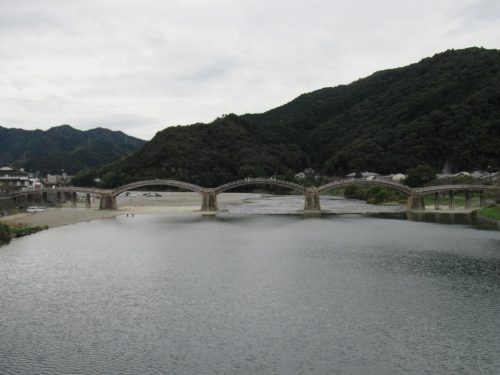
Tourists in Greater Hiroshima tend to flock to Iwakuni because it’s close to Hiroshima Prefecture, but even closer is a small, suburban town called Waki, sandwiched right between Otake, Hiroshima, and Iwakuni, Yamaguchi. Waki is, for the most part, a residential area for the more financially affluent, but there’s one point of interest that draws visitors from other parts of the Chugoku region as possibly even regions farther out: Hachigamine Grand Park. When I went, I was fortunate to have a buddy who could drive me there, but even those without cars can access the hilltop park by taking the JR Red Sanyo Line to Waki Station, and from there, taking a bus to 新港 (しんみなと – Shin-Minato), after which it’s just a 20-something-minute climb. If that’s a little too much to ask, just take a taxi from Waki Station, but regardless of the extra money you pay or the physical effort you exert to reach Hachigamine Park, it’ll all be worth it at the top. This place can be enjoyed to the fullest if you have small children, but big kids and grown-ups can still find some source of amusement from the scenery or athletic possibilities.
Hachigamine Sights
The first sight to greet you will depend on how you approached the park, but all visitors will eventually come up on the hub area with the park information office, café, and some cages containing bunnies, chickens, and a peacock. As for the rabbits, the park staff feed them, but as there are always leftover veggies scattered at the edge of the fence, it’s possible for kids to grab a stray leaf and beckon a bunny over to chow down. Rabbits and chickens are a little too mainstream for me, so I was more captivated by the peacock. It’s just a pity he’s the only one in his cage, unlike the neighboring rooster with a full flock of hens.
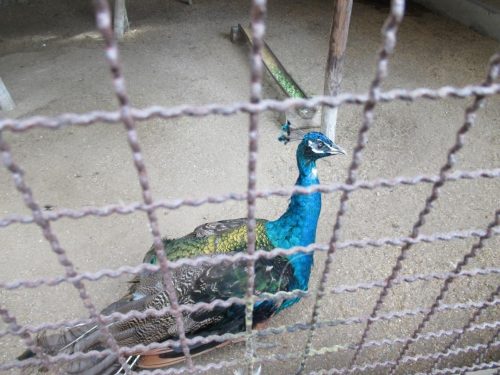
To the southeast, tourists will find the entrance to what seems to be a Dinosaur Park for the kiddos, a rose garden that dazzles in May and October, a golf country club further downhill, and the embarkation point for a steam locomotive that children and their parents can enjoy. Since it was mid-October, and therefore around peak season for roses, I decided to hit up the rose garden first. It’s a wide-open plaza dedicated to roses in almost every hue imaginable, complete with seating space to rest, a public restroom, and a view of the Ferris wheel in the background.

The sky wasn’t as bright as it could’ve been, and May to early June is definitely the prettier of the two viewing periods, but nonetheless, I was impressed by what I saw. I wandered every which way throughout the garden, in awe of all the shades of red, pink, and yellow. A couple of them had a swirl pattern reminiscent of candy or fruit, and one flower was so straight and thorny it could very well serve as an anime character’s weapon of choice!

When we were through with that, we walked over to the dinosaur park, where guests will also find a campground, equipped with spacious ramadas available for rental should you wish to hold a cookout party. Past that is where visitors will find the statues of dinosaurs and other prehistoric reptiles that are sure to fascinate the little ones. However, to say that they are anatomically inaccurate would be an understatement. I mean, look at that Iguanodon dragging its tail on the ground, arms upright like it’s ready to box!
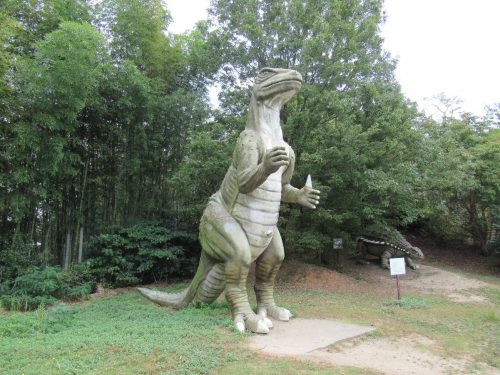
Hachigamine Attractions
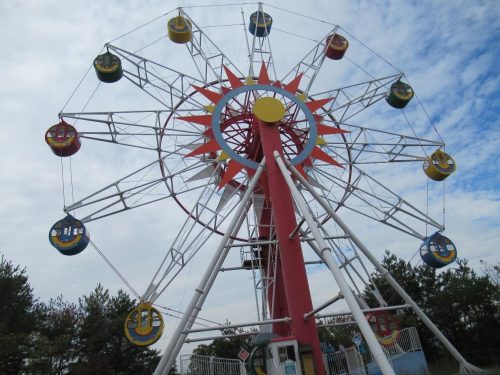
At this point, visitors may want to stop seeing and start doing, but what is there to do at Hachigamine Grand Park? For starters, there’s the Ferris Wheel inside the dinosaur park. Other attractions such as the steam locomotive, obstacle course, and roller slide are dotted all over the park grounds. Those who wish to engage in sports can make use of the ground for baseball and soccer matches, or rent one of the tennis courts for a fee. I debated buying tickets for some of the attractions, but the one must-try at Hachigamine is the roller slide; it’s said to be the longest roller slide in all of Japan!
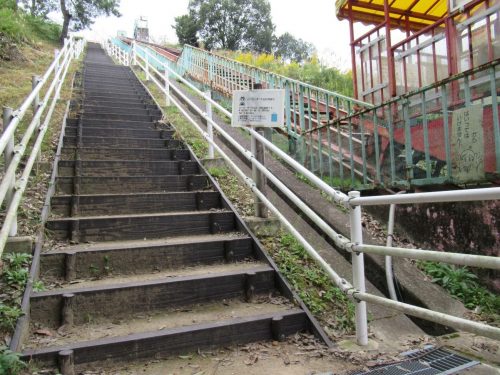
In order to ride, my first order of business was to buy a ticket from the park information office’s vending machine. One ticket allows for three rides down the roller slide per person (sharing tickets is not allowed, but a small child could possibly ride with a parent or guardian). After my ticket came out, I showed it to the man behind the counter and borrowed a blue roller seat pad, which would literally save my butt on the ride. I took my seat pad outside to the super-long staircase leading to the top of the slide, and yes, I climbed this thing three times. Apparently, there used to be a lift to the right of the stairs, but it wasn’t in operation anymore, and local spiders have turned it into their own luxury condo.

Once I reached the top, I set down my seat pad and read the rules posted by the departure point to make sure I slide safely and properly. My friend, being the non-slider, was relegated to holding my stuff and recording videos of me. When sliding, riders should sit up straight with legs in front, but grab the seat pad handle with both hands. I however, chose to be daring and free up one hand to hold my camera so that I could take first-person video footage of the ride (don’t try this at home, kids)! With my friend now at ground level, ready to spot me on the slide, I sat on my seat pad, pulled myself onto the roller track, and gravity did the rest.
Moment of Joy: Budget Coaster
The experience could best be described as a poor man’s roller coaster; the speed at which I slid matches that of kiddy coasters at real amusement parks. The slide wound this way and that, but even without seat belts or safety gear, I was never in danger of falling off the track or injuring myself from inertia. Another key difference between this slide and a kiddy coaster is that riders can adjust the speed with the positioning of their bodies or use their shoes and legs (seriously, wear long pants) as a braking mechanism. The roller slide truly is adrenaline-inducing, even for adults, and the minute I reached the bottom, I ran all the way back and dashed up the stairs to repeat the process until all three rides were complete.
Bandit Feast
All this playtime at Hachigamine Grand Park can make one hungry, so I had to take a lunch break. The café looks like it would whip up some decent fare, but my friend recommended to me an even better choice southwest of central Iwakuni. The restaurant is called いろり山賊 (Irori Sanzoku), technically a chain with three branches, but we drove to the original one located in Kuga. Being up on a hill, the restaurant is best accessed via car, but non-drivers can still get there by taking the JR Gantoku Line from Iwakuni Station to Kinmeiji Station, then walking about fifteen minutes up an incline. The theme of Irori Sanzoku is akin to a Japanese festival, but when we got there, the usual scene was decked out with a Halloween tree and miscellaneous frightful decorations, making me question exactly what holiday the restaurant wanted to celebrate.
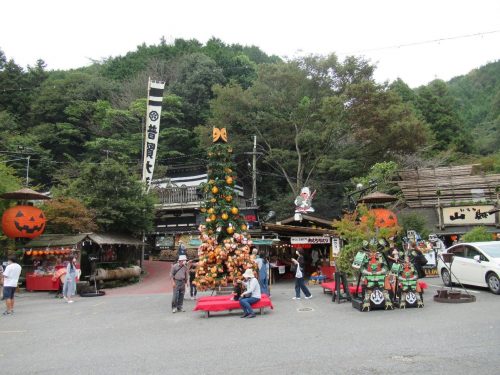
It was a Saturday and the line was long, so my buddy waited in line on my behalf and told me to explore the grounds on my own. Underneath all the gaudy orange was a miniature village waiting to be explored, with separate stores selling all sorts of traditional goods and souvenirs. Irori Sanzoku even has its own Musubi Inari Shrine, with an approach even more exciting than the shrine itself. From the end of the line for the restaurant, I walked toward the corner with the vending machines and turned left. Right before my eyes was a watery path with boulders cropping out in a somewhat straight line; treading carefully across the boulders led me to the entrance of the shrine.
almost our turn, so I said a quick prayer and ran back into line to see the menu and place my order. Diners write the number of each item they want on an order card and hand it to the cashier. If a desired menu item isn’t on the card, the guest can write it in. Those who cannot read or write Japanese can order at the cash register by simply pointing at whatever looks tasty. We paid, told the cashier our names, and then were given a token and told to wait for our food at any available seat.
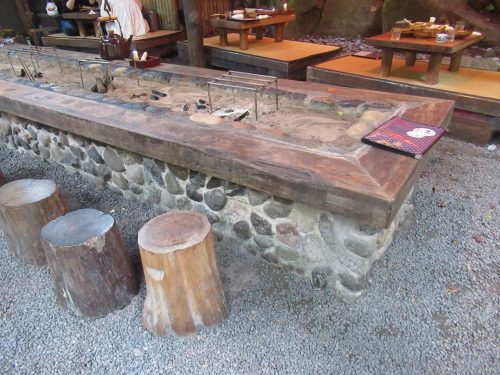
The name “Irori” actually refers to the sunken hearth pictured above, where guest sit if they’re eating anything that constantly needs to stay heated. We didn’t order any of that stuff, so we took off out shoes and sat at a regular “zaseki” table, a raised platform with a tatami surface where diners sit cross-legged. All seating is outdoors so visitors have a scenic view while they wait for their food, as well as fresh air while they eat.
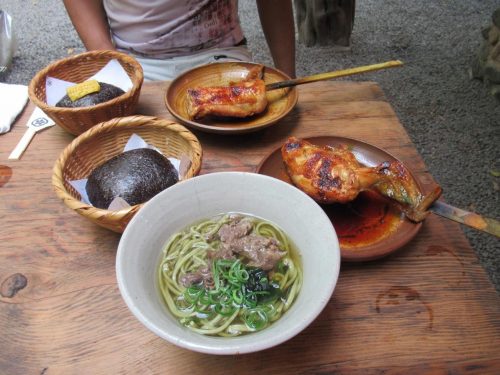
At long last, our food came, and boy, was it worth the wait! Irori Sanzoku’s menu offers a diverse slew of savory Japanese fare, ranging from noodles to gyoza to yakiniku, but their best seller is undoubtedly their “sanzoku-yaki,” which is a teriyaki grilled quarter chicken impaled on a wooden stake, to be eaten just like a sanzoku (mountain bandit) would eat it, hence the “Sanzoku” in the restaurant’s name. As for carbs to pair with the protein, a tried-and-true choice is the “sanzoku musubi,” a gargantuan rice ball filled with ingredients like salmon and pickled plum, then wrapped in a sheet of nori (dried seaweed) and topped off with a Japanese pickle. Biting into the colossal musubi may prove unwieldy and lead to stray clumps of rice dropping all over the table, so the menu instructs diners on how to properly eat the rice ball. First, pick up the musubi with the folded end of the nori facing you. Next, bite normally into the side of the rice ball, as you would with a sandwich, with both hands continuously grasping either side for stability. As you progress through the rice ball and the hole gets bigger, push the sides in to close the hole and reshape the ball. Lather, rinse, and repeat until it’s all gone. Combine the sanzoku-yaki and sanzoku musubi with a bowl of green tea soba, and you’ve got yourself a feast fit for a king of bandits!
Back To Kintaikyo
It’d be remiss for any tourist to Iwakuni to completely skip Kintaikyo, so I saved it for the tail end of my trip. Tourists without a car can access Kintaikyo either via bus from Iwakuni Station or a fifteen-minute walk from Kawanishi Station. When we arrived at the south end of Kintaikyo, rather than pay the admission fee to cross, we instead opted for the adjacent bridge that costs nothing, yet affords opportunities for phenomenal photos of Kintaikyo like the one at the top of this page.
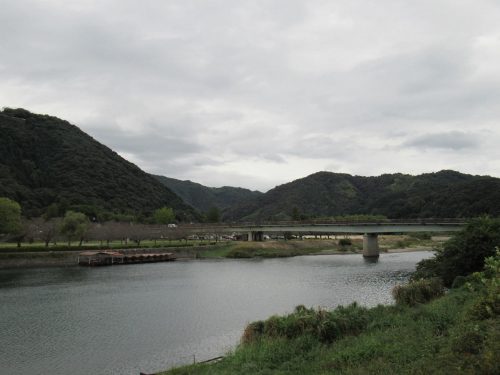
This alternate bridge is not at all far from Kintaikyo, and still leads to Kikko Park, which, in my opinion, is where most of Iwakuni’s fun tourist spots are. At this point, the museums were about to close, so the only thing to do was to buy an ice cream cone from one of the stores. We chose a parlor called Musashi, which offers an inexhaustible selection of flavors, several of which are only available for a limited time. I got myself an orange chocolate cone, and we proceeded to the base of Kintaikyo, where I dug into my already melting ice cream.
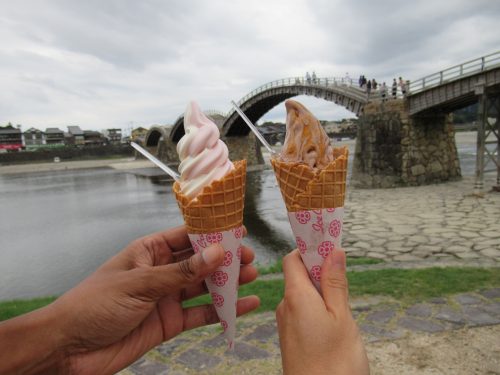
By the time we finished our ice cream, it was well past 5:00 p.m., after which point visitors can walk across Kintaikyo for free (this was all a part of my plan). Regardless of season, dusk is an optimal time to enjoy the bridge as temperatures will be cooler by then, and if you stick around long enough, you might be able to see the sunset from here. Unfortunately, as it was starting to rain, we doubled back to the south side where we began, made our way to Iwakuni Station, and then said our goodbyes.

As you can see, my trip took the whole day, and I didn’t even come close to seeing all the famous tourist sites in the Iwakuni area. Most of my adventures today consisted of less mainstream places, so if you wish to see the staple sites as well as stuff further out of town, Iwakuni warrants at least two days. Visitors may want to consider spending a night in Iwakuni to see Kintaikyo light up at night and continue where they left off the next morning. With places like Hachigamine Grand Park and Irori Sanzoku added to the mix, there’s more to see here than meets the eye, and it’s appealing to the whole family to boot. If you ever have the chance to swing by Iwakuni, definitely take the time to explore the usual points of interest, but to enjoy this area to the fullest, you need to go beyond Kintaikyo and scope out the overlooked attractions like a local would.






